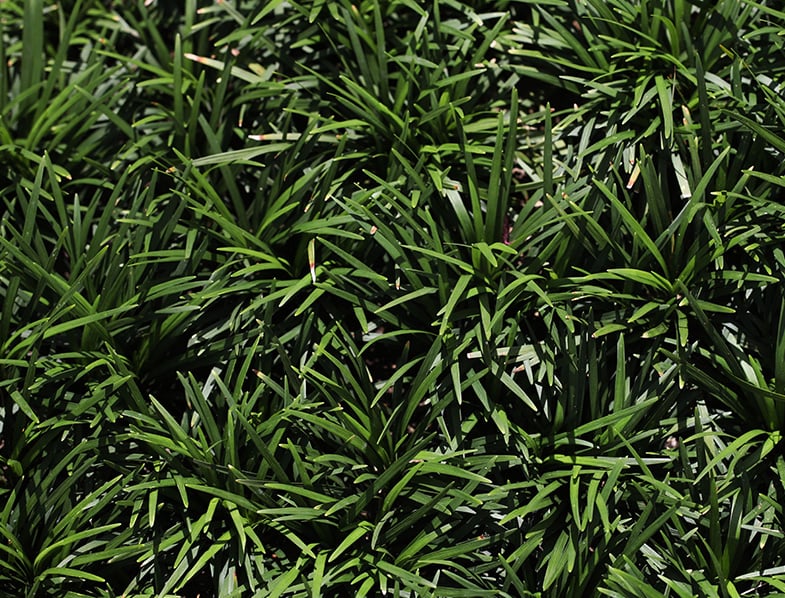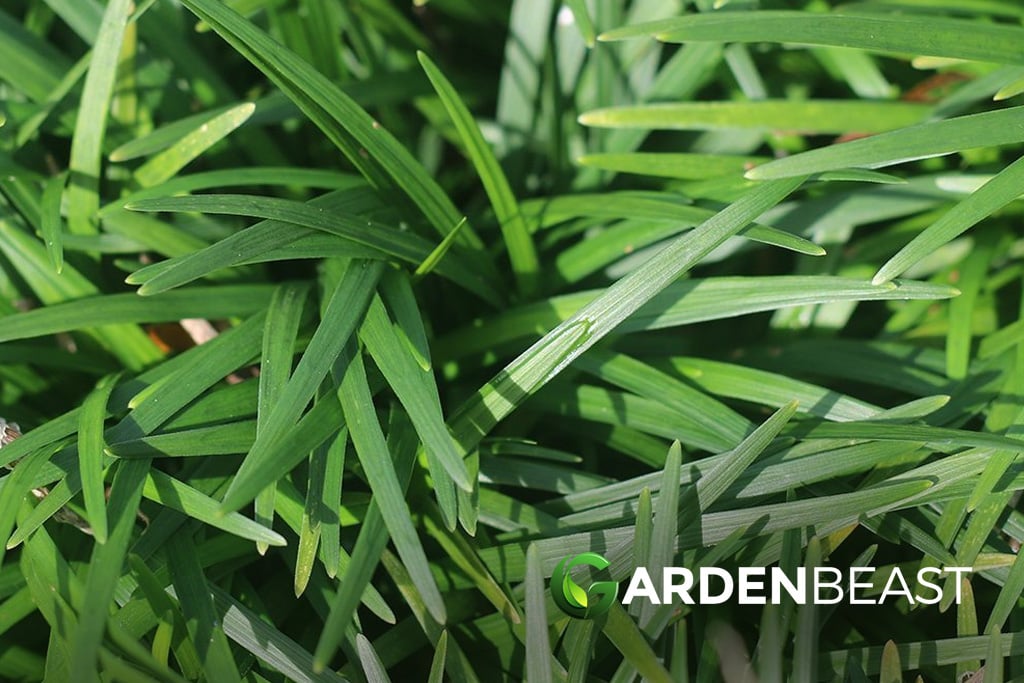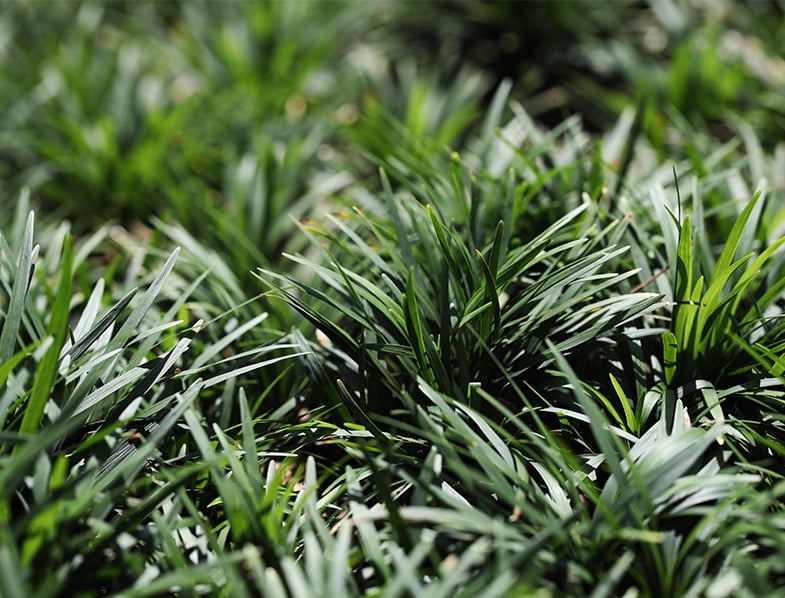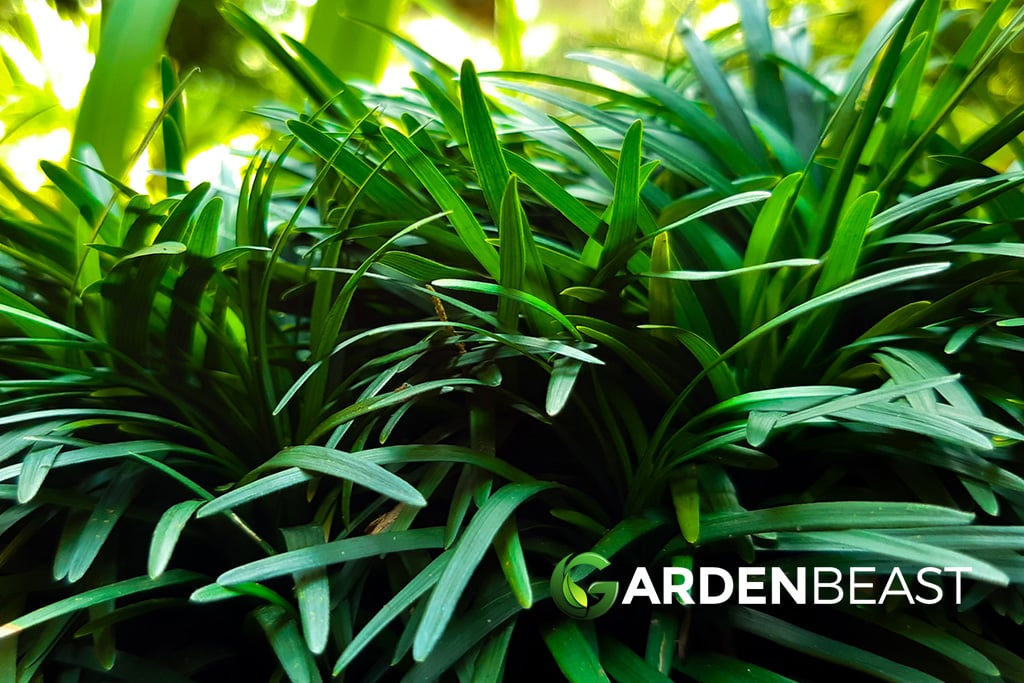Monkey grass is a plant with an entertaining name and an eye-pleasing effect for your landscaping needs. Also known as, “mondo grass,” monkey grass is an ornamental type that suits planting in a variety of growing conditions.
This form of ornamental grass is hardy, and its robust nature allows for it to survive in all kinds of weather conditions.
With minimal maintenance required, and no need to break out the lawnmower, monkey grass is an excellent choice for areas of the garden where you want to enhance the visual aspects of the landscape.
With excellent resistance to pests and critters like deer, monkey grass grows without any special care requirements, and it can get by in drought conditions as well. Monkey grass grows well in all lighting environments as well, spreading in shady areas of the yard without much effort.
Use monkey grass to line the edges of your flowerbeds, giving your garden a landscaped look that’s simply fantastic.
Quick Facts
| Fact | Details |
|---|---|
| Varieties | Black Monkey Grass, Dwarf Monkey Grass |
| Ideal Growing Conditions | Grows well in USDA zones 7 – 11, can survive in all lighting conditions, prefers slightly acidic soil |
| Maintenance | Minimal; requires occasional watering and weeding, should be divided and replanted every 3 years |
| Pests and Diseases | Resistant to most pests and diseases; can develop root rot in overly moist soil |
| Uses in Garden | Can be used to line the edges of flowerbeds, provide ground cover, and as a lawn replacement in dry regions |
| Watering Requirements | Moderate; soil should be allowed to dry out between watering to prevent root rot |
| Fertilizer Requirements | Can benefit from diluted liquid plant fertilizer |
| Propagation | Easy to grow from seeds or starter plants with root systems |
| Key Pests | Slugs and snails |
| Pest Control | Slug and snail bait can be used around the base of the plants |
Varieties of Monkey Grass
There are two popular types of monkey grass available, with each of them offering the unique characteristics to suit a variety of yards and growing conditions.
Black Monkey Grass
This monkey grass variety gives your yard an eye-catching aesthetic appeal that visitors to your home will find surprising. With a darker color than other types of monkey grass, this variety grows slowly, suiting low-light areas of the garden, such as under shrubs and trees.
The stolons that appear under the surface of the soil cause the plant to branch out during the growing season. If you’re growing black monkey grass in the garden in the full sunlight, then remember to water frequently, as this variety is very thirsty, especially in warm weather.
Black monkey grass grows to lengths of 10-inches tall, and it starts to flower in the late summer months. As the growing season progresses, the foliage on the plant begins to turn from green to black, giving the characteristic look of this monkey grass variety.
Black monkey grass is resistant to the cold and does well during the winter months.
- 18 count flat of 3.5 inch pots
- Partial shade to full sun
- Maybe winter dormant, no foliage (picture not representative)
- Ornamental grass: Variegated Liriope, also known as Variegated Lilyturf, is an evergreen perennial plant with green and white striped leaves. It typically grows to a height of 12-18 inches (30-45 cm) and spreads to form a dense clump. In late summer, it produces spikes of small purple flowers
- Uses: Variegated Liriope is a versatile plant that can be used in many ways. It's commonly used as a ground cover, edging plant, or accent plant. It also works well in containers or hanging baskets.
- Care: Variegated Liriope is a low-maintenance plant that's easy to care for. It prefers partial to full shade and moist, well-drained soil. It's also drought tolerant once established. It's important to avoid overwatering, as this can lead to root rot.
- USDA Growing Zone: Variegated Liriope is hardy in USDA zones 5-10. It can tolerate cold temperatures down to -15°F.
- Short, dark green foliage, tiny, white flowers turn to blue berries in fall, spreads by stolons.
- Shade, partial shade to full sun
- Evergreen, hardy in zones 7-10
Last update on 2025-08-29 / Affiliate links / Images from Amazon Product Advertising API
Dwarf Monkey Grass
This variety of monkey grass is the result of a breeding program, producing monkey grass that only grows to a height of two to four inches. The Dwarf monkey grass plant features slender foliage that gives it a petite look.
Use dwarf monkey grass in the garden to provide groundcover for your flowerbeds. This variety of monkey grass is also very hardy and resistant to cold weather.

Optimal Growing Conditions for Monkey Grass
Owning a patch of monkey grass is the dream of every gardener. They require little maintenance throughout the growing season, making them the ideal plant for areas of the garden, such as slopes next to retaining walls.
Monkey grass grows well in USDA zones 7 – 11, and the hardy characteristics of the plant make it a top choice for gardeners working with state water restrictions in drought conditions.
Caring for Monkey Grass
Gardeners will love the low maintenance requirements of planting monkey grass in the garden. As long as you occasionally water the plants, and weed throughout the growing season, you won’t get very many issues with your monkey grass plants.
The plants grow readily, and to contain their spread, the gardener will need to dig up the monkey grass every 3-years and divide the roots. Replant the clumps in different regions, and let the grass continue its spread through the growing area.

Propagating and Growing Monkey Grass
Monkey grass is easy for gardeners to grow and propagate. Visit your local garden center or nursery for a packet of monkey grass seeds. Most nurseries will have starter plants that already have root systems, making it easy to establish your monkey grass in the garden.
Weeds present the most significant challenge for monkey grass during the growing season. To keep weeds from crowding out your monkey grass, place a layer of mulch around the base of the plants to limit sunlight reaching the soil.
Plant your monkey grass in the early spring, after the final frosts fall to the ground. It’s possible to plant starter monkey grass plants later in the season, provided that they have enough time left in the growing season to establish a robust root system.
It’s for this reason that it’s better to plant in the early springtime, giving your monkey grass as much time as possible to establish roots and start to thrive.
Use dwarf varieties of monkey grass to line the borders of your flowerbeds, providing your flowers with protection from pests.
Planting Monkey Grass
Start the plating process by digging a hole in the ideal planting site in your yard. Dig the hole at least 18-inches deep to loosen the ground and ensure adequate drainage of water away from the roots. Roots that sit in soggy soil will end up developing root rot.
Add some organic compost to the bottom of the hole, and work it into the ground with a garden fork. Monkey grass prefers growing in soils with a slightly acidic pH balance. Plant your grass to the height of the cell packs above the roots and plant monkey grass 6 to 8-inches apart to give the plants room to grow into each other.
Monkey grass grows readily in soils with no amendments., However, you can boost growth by adding some diluted liquid plant fertilizer to your monkey grass in the early spring before the first few seasons after planting.

Using Monkey Grass for Your Lawn
Monkey grass is a versatile plant that does well in a variety of growing conditions. Use it to bring some extra life into your flowerbeds, covering up sparse areas of the garden that look bare.
Those gardeners living in dry regions of the United States, such as Nevada, can use monkey grass for a lawn replacement.
Pests and Diseases Affecting Your Monkey Grass
When monkey grass has its roots remain in overly moist soil for too long, it starts to develop root rot. You’ll know the roots are in trouble when the foliage of the plant starts to experience discoloration.
Monkey grass is reasonably resistant to diseases and pests, but “wet feet” in the plants leads to the onset of root rot in all varieties of monkey grass.
The first signs of root rot appearing in your monkey grass is when the tips of the leaves start to turn yellow and brown, and then die back. To keep the plant from succumbing to the root rot, gardeners need to treat the monkey grass with an organic fungicide to kill the pathogens.
Dilute the organic fungicide at a ratio of half a fluid ounce to a gallon of water. A gallon should suffice to cover 10-sq ft of garden area. Wait for the weather to get sunny and dry, and then spray down the plants to kill the fungal infection around the roots.
Adding a layer of mulch to the base of the plants also helps to limit the occurrence of root rot. Compost and bark chips contain natural microorganisms that fight off the invading fungus, restoring the monkey grass to health.

Avoid Overwatering Monkey Grass
As mentioned, if the roots of your monkey grass sit in water for too long, it causes the onset of root rot in the plant. The most common reason for root rot emerging in your monkey grass is the overwatering of the plants.
Monkey grass doesn’t need much water to thrive in the garden, which is one of the reasons why it’s such a drought-resistant plant. If you overwater the plant, and the soil does not drain the water away effectively, root rot will eventually show up in your monkey grass.
Let the plants dry out completely between waterings to avoid the emergence of root rot.
Pest Control for Your Monkey Grass
Slugs and snails are the most common pests affecting monkey grass. When these pests start to attack your monkey grass, you’ll notice the appearance of the grass dying. Purchase some snail and slug bait from your local garden center, and leave it around the base of the plants to kill the pests.
Snails and slugs start to come out after the rain. Therefore, gardeners must inspect their monkey grass after the rains stop, and toss away any snails or slugs they find slithering around the plants.
Gardeners don’t have to worry about the slug bait killing off any other local wildlife, as the ingredients only become active after repeat feedings. As soon as the slugs start feeding on the bait, they leave your monkey grass alone.
Spread the bait granules around the base of the plants, around 3-inches apart from each other. Check back on the bait stations over the next few days to look for evidence of dead snails and slugs.
In Closing
Monkey grass is an ideal alternative to planting traditional grass in your garden, especially in hot and dry climates around the United States. The evergreen characteristics of monkey grass keep it looking fantastic all-year-round.
The slow-growing characteristics of monkey grass also make it an ideal plant for training in other regions of the garden as well.
Monkey Grass FAQS
Is monkey grass easy to grow?
Yes, monkey grass is considered quite easy to grow. It’s hardy, adaptable, and requires minimal maintenance, making it an ideal choice for both novice and experienced gardeners.
Where is the best place to plant monkey grass?
Monkey grass thrives in a variety of lighting conditions, from full sun to full shade. It can be planted under trees or shrubs, in flower beds, or used as edging for walkways or borders. It also does well in slopes next to retaining walls.
How much sun does monkey grass need?
Monkey grass grows well in all lighting environments. It can thrive in full sun, partial shade, and even full shade. However, the color and growth rate of the grass can be influenced by the amount of sunlight it receives.
How do you start monkey grass?
Monkey grass can be started from seeds or starter plants that already have root systems. The plants should be placed in holes that are 18 inches deep and spaced 6 to 8 inches apart to allow room for growth. Adding some organic compost or a diluted liquid plant fertilizer can boost growth.
What happens if you don’t cut monkey grass?
If you don’t cut monkey grass, it continues to grow and can spread out significantly. It’s recommended to divide the plant and replant the divisions every 3 years to manage its spread. However, not cutting monkey grass won’t harm the plant; it’s more a matter of controlling its size and spread.
Does monkey grass survive winter?
Yes, monkey grass is a hardy plant that can survive winter conditions, especially the black monkey grass and dwarf monkey grass varieties. Its evergreen characteristics keep it looking lively all year round. However, it’s most suitable for growing in USDA zones 7 – 11, where winters are typically milder.



